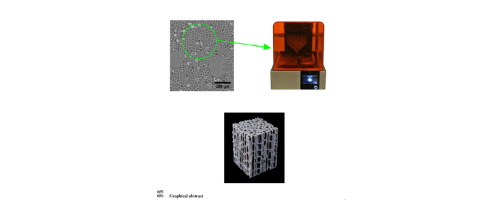Acta Biomaterialia ( IF 9.4 ) Pub Date : 2017-12-30 , DOI: 10.1016/j.actbio.2017.12.036 P.G. Dixon , J.T. Muth , X. Xiao , M.A. Skylar-Scott , J.A. Lewis , L.J. Gibson

|
Bamboo is a sustainable, lightweight material that is widely used in structural applications. To fully develop micromechanical models for plants, such as bamboo, the mechanical properties of each individual type of tissue are needed. However, separating individual tissues and testing them mechanically is challenging. Here, we report an alternative approach in which micro X- ray computed tomography (µ-CT) is used to image moso bamboo (Phyllostachys pubescens). The acquired images, which correspond to the 3D structure of the parenchyma, are then transformed into physical, albeit larger scale, structures by 3D printing, and their mechanical properties are characterized. The normalized longitudinal Young’s moduli of the fabricated structures depend on relative density raised to a power between 2 and 3, suggesting that elastic deformation of the parenchyma cellular structure involves considerable cell wall bending. The mechanical behavior of other biological tissues may also be elucidated using this approach.
Statement of Significance
Bamboo is a lightweight, sustainable engineering material widely used in structural applications. By combining micro X-ray computed tomography and 3D printing, we have produced bamboo parenchyma mimics and characterized their stiffness. Using this approach, we gained insight into bamboo parenchyma tissue mechanics, specifically the cellular geometry’s role in longitudinal elasticity.
中文翻译:

3D打印结构,用于建模竹实质的杨氏模量
竹子是一种可持续的,轻质的材料,广泛用于结构应用中。为了完全开发植物(例如竹子)的微机械模型,需要每种单独类型的组织的机械特性。然而,分离单个组织并对其进行机械测试是具有挑战性的。在这里,我们报告了一种替代方法,其中使用微型X射线计算机断层扫描(µ-CT)对毛竹进行成像(Phyllostachys pubescens)。然后,通过3D打印将与薄壁组织的3D结构相对应的获取的图像转换为物理(尽管规模较大)结构,并对其机械性能进行表征。所制造的结构的标准化纵向杨氏模量取决于相对密度提高到2到3之间的幂,这表明薄壁细胞结构的弹性变形涉及相当大的细胞壁弯曲。使用这种方法还可以阐明其他生物组织的机械行为。
重要声明
竹是一种轻质,可持续的工程材料,广泛用于结构应用中。通过将X射线计算机断层扫描和3D打印相结合,我们制作了竹实质模拟物并对其刚度进行了表征。使用这种方法,我们深入了解了竹实质组织力学,特别是细胞几何结构在纵向弹性中的作用。











































 京公网安备 11010802027423号
京公网安备 11010802027423号